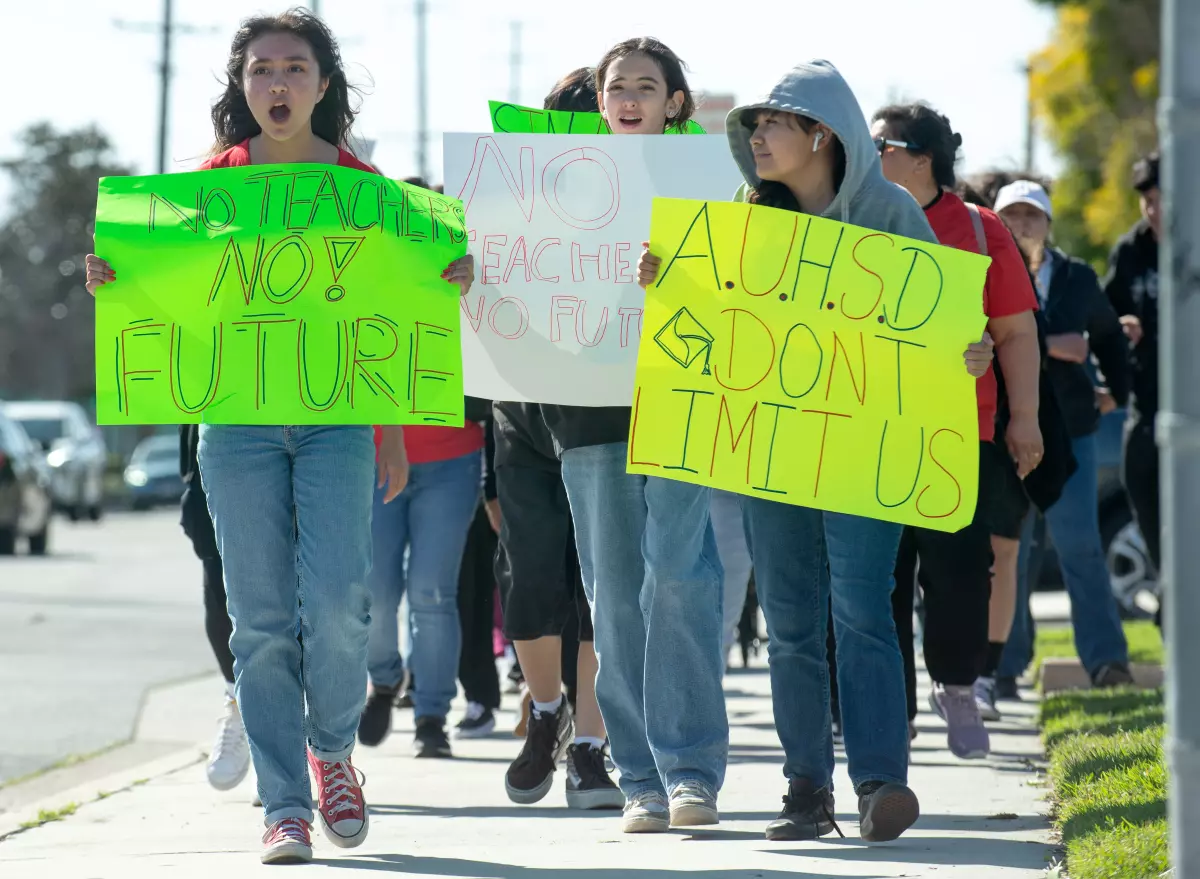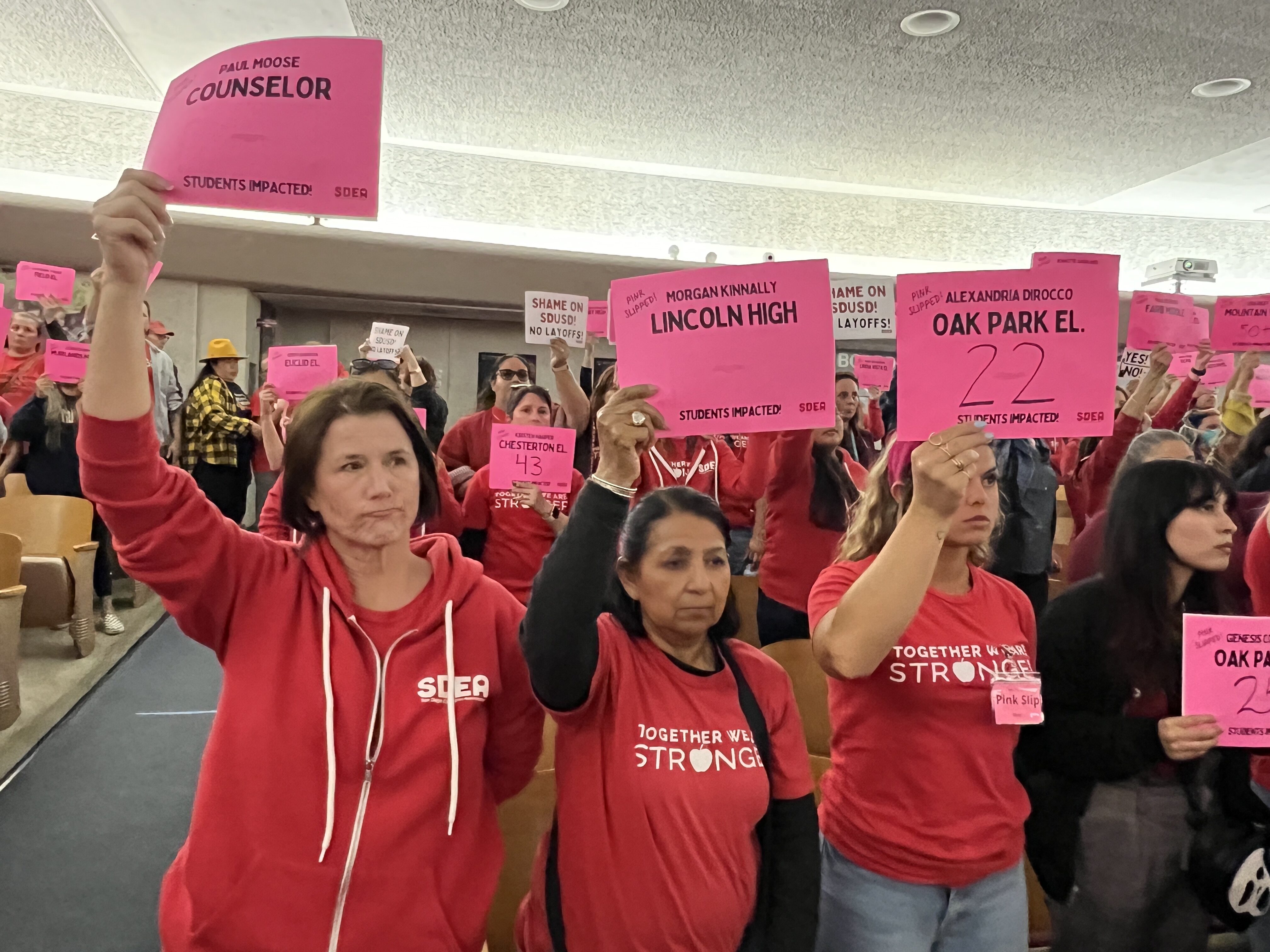

In mid-March, students, parents and community members marched from Brookhurst Junior High to the Anaheim Union High School District offices in protest of cuts that aim to reduce teacher staffing by 10%. Photo courtesy LA Times.
Educators and their local associations across the state are organizing to fight against proposed layoffs in school districts statewide — with more than 2,000 Reduction In Force (RIF) notices reported in 94 districts this year, a figure that could increase as additional reports are submitted. Local chapters are fighting back to demand that RIF notices are rescinded in the coming months.
“While our union works to ensure that all educators’ rights are maintained in this process across the state, we’re also calling on districts to rescind layoff notices and bring back educators for the next school year.”
—CTA President David Goldberg
The number is a massive increase from recent years, reminding of difficult budget years more than a decade ago when school districts balanced their budgets on the backs of their dedicated educators and the students and communities they serve.

San Diego Education Association sign
“This is a traumatic and stressful experience for any educator, and layoffs ultimately harm students and our communities,” says CTA President David Goldberg. “While our union works to ensure that all educators’ rights are maintained in this process across the state, we’re also calling on districts to rescind these layoff notices and bring back educators for the next school year.”
In many of the cases, the spike in layoff notices are an overreaction by school districts to a projected deficit in the state budget. But rather than recognize that “rainy days” are here and tapping into reserve funds, many districts are hoarding reserves and instead proposing layoffs.
“Districts should be exhausting their reserves and looking for other ways to balance their budgets before laying off educators,” Goldberg says. “Our students deserve fully staffed schools — now is not the time to be laying off educators.”
The short-sighted layoff proposals come during a severe educator shortage, and will only compound the issue, causing aspiring teachers to reconsider whether they want to start in a career where they fear getting a pink slip every spring. And for seasoned educators, the layoff notices mean the potential for doing even more with even less — adding more and more onto the plates of an already exhausted and understaffed educator workforce.
Despite California’s economic power as the fifth largest economy in the world, our K–12 public schools are chronically underfunded, meaning that fluctuations in the state budget often lead to instability, Goldberg says.

At a school board meeting, SDEA members held “pink slips” received by educators, along with the number of students who will be impacted by their layoffs.
“We need to fix California’s broken school funding system,” he says. “California’s students, schools and communities deserve a more stable and robust funding system to support an equitable education system for all.”
CTA local associations are already organizing to fight back layoff proposals. Anaheim Secondary Teachers Association held a march and rally in March to shine a light on the impacts of more than 100 proposed layoffs, while San Diego Education Association (SDEA) members rallied outside the San Diego Unified School District office later that month to protest the proposed layoff of 178 educators.
“Anything that we’re doing as a district that’s going to dissuade people from applying for positions where we so badly need quality educators is a huge mistake,” SDEA President Kyle Weinberg said in a news interview. “We need to be moving in the direction of bringing more educators, more counselors, more psychologists into our schools, and we’re going in the opposite direction as a district. It’s heartbreaking.”
Educator Layoffs Proposed Across State
Most layoff notices (credentialed and classified) issued as of March 26:
- San Francisco Unified School District — 236
- San Diego Unified School District — 178.5
- Anaheim Union High School District — 119
- Chula Vista Elementary School District — 77.42
- Los Angeles County Office of Education — 72
- Coachella Valley Unified School District — 70
- Pasadena Unified School District— 64.6
- William S. Hart Union High School District — 63
- Santa Rosa Unified School District — 57.9
- Inglewood Teachers Association — 52



The Discussion 0 comments Post a Comment